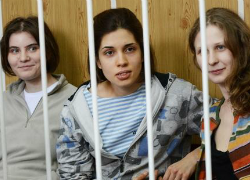
(Amnesty International)
On August 17, 2012, Nadezhda Tolokonnikova, Yekaterina Samutsevich, and Maria Alyokhina, members of the Russian punk band, Pussy Riot, were found guilty of “hooliganism motivated by religious hatred” and sentenced to two years in a penal colony for their open protest of Russia’s President Vladimir Putin. The band argued that their political protest, which involved the balaclava-clad crew performing the anti-Putin song, “Virgin Mary, Cast Putin Out,” in Moscow’s Russian Orthodox Christ the Savior Cathedral, was merely a display of artistic expression. The courts clearly disagreed. Penalizing Pussy Riot exhibits the treatment of artistic expression as religious hate crimes in Putin’s Russia.
The Pussy Riot protest is not the first instance of artistic expression with religious subtext being penalized in Russia. In 2005, an art exhibit entitled “Caution! Religion,” featuring 42 pieces of art meant to provoke discussion on the role of religion in society, was on display at the Andrei Sakharov Museum in Moscow. Within days of opening, the exhibit suffered vandalism at the hands of a Russian nationalist group called Movement for the Renewal of the Fatherland. The vandals were charged with “hooliganism,” but these charges were dropped after the Russian Orthodox Church intervened.
Instead, museum director Yuri Samodurov and his assistant Lyudmila Vasilovskaya were charged with “inciting ethnic and religious hatred” for the artistic display, each being fined $100,000 rubles. This surprising contradiction is a perfect example of the powerful role the Russian Orthodox Church seems to play within the Russian political landscape.
Similarly, in 2006, the “Forbidden Art Exhibit” was also on display at the Andrei Sakharov Museum in Moscow. The exhibit featured 20 artistic pieces all previously rejected by other exhibits. One featured piece included a depiction of Mickey Mouse as Jesus Christ and another image depicted Lenin on a cross. This blending of religious and political imagery was not well received by the Church. The director of the museum, Yuri Samodurov, and the curator for the exhibit, Andrei Erofeev, were both found guilty of “incitement of religious and ethnic hatred” and were fined 200,000 and 150,000 rubles, respectively.
What is interesting about the “Forbidden Art Exhibit” case is the outpour of support from fellow artists that came about after the charges were raised. These positive endorsements demonstrated that Russian artists were fully aware of the hold that the Russian Orthodox Church has on Russia’s political arena, and the limits on creative expression within modern Russian art movements. Public outcry for the Pussy Riot incident mounted with similar fervor, perhaps on a larger scale, as the international community, including Amnesty International, became involved. The question, as it stands now, is whether the Russian government will take these protests as sign to strive for a less theocratic leaning.
Stacy Harper is a 2L at Denver University Law School and a Staff Editor for the Denver Journal of International Law and Policy.


